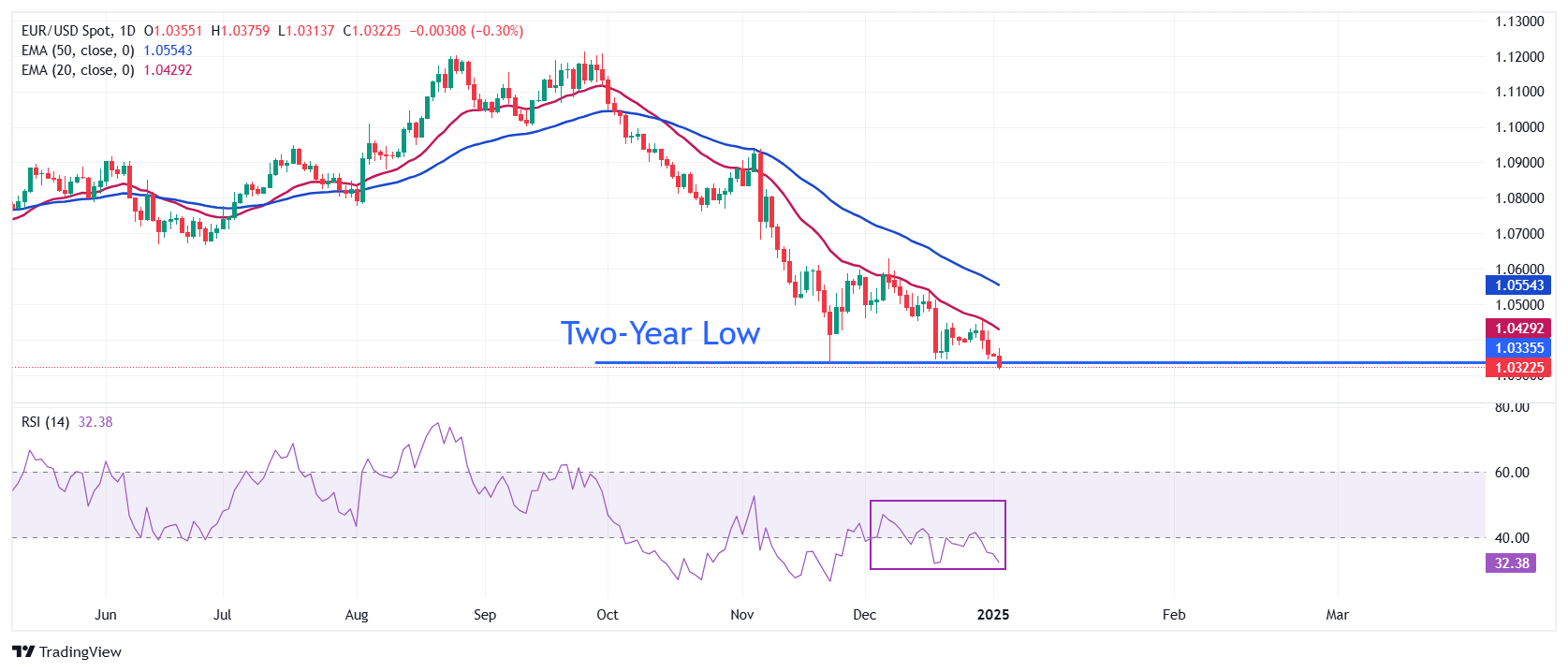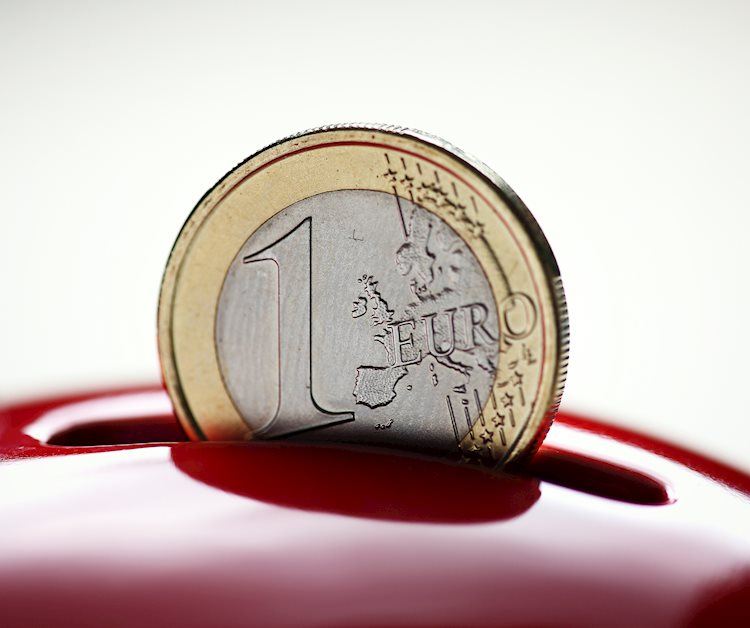EUR/USD weakens on lower US Initial Jobless Claims
- EUR/USD declines below a two-year low of 1.0330 as the US Dollar gains further.
- The USD gains as the Fed has guided fewer rate cuts in 2025.
- Investors expect the ECB to cut interest rates steadily by 25 bps in each meeting till June.
EUR/USD declines to near 1.0310 on the first trading day of the year, the lowest level seen in more than two years. The major currency pair weakens as the US Dollar (USD) extends its upside, with the Dollar Index (DXY) rising above 108.80, as the United States (US) Initial Jobless Claims for the week ending December 27 have come in lower than expected. Individuals claiming jobless benefits for the first time were 211K, lower than estimates of 222K and the former release of 220K.
Additionally, optimism that the Federal Reserve (Fed) will reduce interest rates less than previously anticipated this year has also kept the US Dollar on the frontfoot. The Fed cut its key borrowing rates by 100 basis points (bps) in 2024 as policymakers were more worried about higher risks to employment than upside risks to inflation. However, they have guided fewer interest rate cuts for this year amid an upbeat US economic outlook. Additionally, a slowdown in the disinflation trend also compelled officials to favor a gradual policy-easing cycle.
The latest dot plot at the Fed's Summary of Economic Projections showed that policymakers collectively see Federal Fund rates heading to 3.9% by the end of 2025, higher than the 3.4% forecasted in September.
According to the CME FedWatch tool, the central bank is almost certain to keep interest rates unchanged in the range of 4.25%-4.50% in the January meeting.
Going forward, the US Dollar will be guided by the United States (US) ISM Manufacturing Purchasing Managers Index (PMI) data for December, which will be released on Friday. The PMI is expected to tick lower to 48.3 from the prior release of 48.4, suggesting that the manufacturing sector activities contracted at a slightly faster pace.
US Dollar PRICE Today
The table below shows the percentage change of US Dollar (USD) against listed major currencies today. US Dollar was the strongest against the British Pound.
| USD | EUR | GBP | JPY | CAD | AUD | NZD | CHF | |
|---|---|---|---|---|---|---|---|---|
| USD | 0.37% | 0.88% | -0.31% | 0.25% | -0.44% | -0.31% | 0.24% | |
| EUR | -0.37% | 0.44% | -0.63% | -0.13% | -0.77% | -0.72% | -0.13% | |
| GBP | -0.88% | -0.44% | -1.07% | -0.62% | -1.31% | -1.17% | -0.67% | |
| JPY | 0.31% | 0.63% | 1.07% | 0.49% | -0.18% | -0.11% | 0.45% | |
| CAD | -0.25% | 0.13% | 0.62% | -0.49% | -0.69% | -0.59% | -0.02% | |
| AUD | 0.44% | 0.77% | 1.31% | 0.18% | 0.69% | 0.05% | 0.47% | |
| NZD | 0.31% | 0.72% | 1.17% | 0.11% | 0.59% | -0.05% | 0.62% | |
| CHF | -0.24% | 0.13% | 0.67% | -0.45% | 0.02% | -0.47% | -0.62% |
The heat map shows percentage changes of major currencies against each other. The base currency is picked from the left column, while the quote currency is picked from the top row. For example, if you pick the US Dollar from the left column and move along the horizontal line to the Japanese Yen, the percentage change displayed in the box will represent USD (base)/JPY (quote).
Daily digest market movers: EUR/USD declines on weak HCOB Manufacturing PMI
- EUR/USD is also under pressure due to the weak Euro’s (EUR) outlook. The shared currency faces selling pressure as the final estimates for HCOB Manufacturing PMI for December showed that factory activities contracted at a slightly faster pace to 45.1 from the preliminary reading of 45.2.
- Additionally, the European Central Bank (ECB) is expected to continue its steady rate-cut cycle until June, which is also an unfavorable situation for the Euro. This suggests that there will be four interest rate cuts, pushing the Deposit Facility rate lower to 2%.
- Market participants expect further policy easing as Eurozone price pressures are on track to return sustainably to the ECB’s target of 2%.
- Additionally, investors price in a sharp decline in European exports due to higher import tariffs from the US under the administration of incoming President Donald Trump.
- For more cues on inflation, investors await preliminary German and Eurozone Harmonized Index of Consumer Prices (HICP) data for December, which will be released early next week. Investors will pay close attention to the HICP data as it will indicate whether the ECB will continue easing interest rates at a steady pace of 25 basis points (bps) or pivot to a larger-than-usual pace of 50 bps.
- ECB policymaker and Irish central bank chief Gabriel Makhlouf warned in an interview with the Financial Times (FT) on December 23 that some elements of services inflation in the Eurozone were a bit concerning, which underscores the need for “gradual interest rate cuts, rather than big leaps” unless the facts and evidence changed.
Technical Analysis: EUR/USD breaks below 1.0330

EUR/USD stays below the two-year low of 1.0330 in Thursday's North American session. The outlook of the major currency pair was already bearish as the 20-day and 50-day Exponential Moving Averages (EMAs) at 1.0433 and 1.0556, respectively, are declining.
The 14-day Relative Strength Index (RSI) slides below 40.00, indicating a strong downside momentum.
Looking down, the pair could find support near the round-level support of 1.0200. Conversely, the psychological resistance of 1.0500 will be the key barrier for the Euro bulls.
Forex News
Keep up with the financial markets, know what's happening and what is affecting the markets with our latest market updates. Analyze market movers, trends and build your trading strategies accordingly.





















